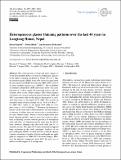Files in this item
Heterogeneous glacier thinning patterns over the last 40 years in Langtang Himal, Nepal
Item metadata
| dc.contributor.author | Ragettli, Silvan | |
| dc.contributor.author | Bolch, Tobias | |
| dc.contributor.author | Pellicciotti, Francesca | |
| dc.date.accessioned | 2019-03-13T15:30:11Z | |
| dc.date.available | 2019-03-13T15:30:11Z | |
| dc.date.issued | 2016-09-14 | |
| dc.identifier | 258136665 | |
| dc.identifier | 7fc9b10f-b1fd-4d29-a5de-2f6d7741fa36 | |
| dc.identifier | 84988378183 | |
| dc.identifier.citation | Ragettli , S , Bolch , T & Pellicciotti , F 2016 , ' Heterogeneous glacier thinning patterns over the last 40 years in Langtang Himal, Nepal ' , The Cryosphere , vol. 10 , no. 5 , pp. 2075-2097 . https://doi.org/10.5194/tc-10-2075-2016 | en |
| dc.identifier.issn | 1994-0416 | |
| dc.identifier.other | ORCID: /0000-0002-8201-5059/work/55379124 | |
| dc.identifier.uri | https://hdl.handle.net/10023/17280 | |
| dc.description.abstract | This study presents volume and mass changes of seven (five partially debris-covered, two debris-free) glaciers in the upper Langtang catchment in Nepal. We use a digital elevation model (DEM) from 1974 stereo Hexagon satellite data and seven DEMs derived from 2006–2015 stereo or tri-stereo satellite imagery (e.g., SPOT6/7). The availability of multiple independent DEM differences allows the identification of a robust signal and narrowing down of the uncertainty about recent volume changes. The volume changes calculated over several multiyear periods between 2006 and 2015 consistently indicate that glacier thinning has accelerated with respect to the period 1974–2006. We calculate an ensemble-mean elevation change rate of –0.45ĝ€#x000B1;ĝ€0.18ĝ€mĝ€a−1 for 2006–2015, while for the period 1974–2006 we compute a rate of −0.24ĝ€±ĝ€0.08ĝ€mĝ€a−1. However, the behavior of glaciers in the study area is heterogeneous, and the presence or absence of debris does not seem to be a good predictor for mass balance trends. Debris-covered tongues have nonlinear thinning profiles, and we show that recent accelerations in thinning correlate with the presence of supraglacial cliffs and lakes. At stagnating glacier areas near the glacier front, however, thinning rates decreased with time or remained constant. The April 2015 Nepal earthquake triggered large avalanches in the study catchment. Analysis of two post-earthquake DEMs revealed that the avalanche deposit volumes remaining 6 months after the earthquake are negligible in comparison to 2006–2015 elevation changes. However, the deposits compensate about 40ĝ€% the mass loss of debris-covered tongues of 1 average year. | |
| dc.format.extent | 23 | |
| dc.format.extent | 9804955 | |
| dc.language.iso | eng | |
| dc.relation.ispartof | The Cryosphere | en |
| dc.subject | GE Environmental Sciences | en |
| dc.subject | Water Science and Technology | en |
| dc.subject | Earth-Surface Processes | en |
| dc.subject | 3rd-DAS | en |
| dc.subject.lcc | GE | en |
| dc.title | Heterogeneous glacier thinning patterns over the last 40 years in Langtang Himal, Nepal | en |
| dc.type | Journal article | en |
| dc.contributor.institution | University of St Andrews. School of Geography & Sustainable Development | en |
| dc.contributor.institution | University of St Andrews. Bell-Edwards Geographic Data Institute | en |
| dc.identifier.doi | 10.5194/tc-10-2075-2016 | |
| dc.description.status | Peer reviewed | en |
This item appears in the following Collection(s)
Items in the St Andrews Research Repository are protected by copyright, with all rights reserved, unless otherwise indicated.

